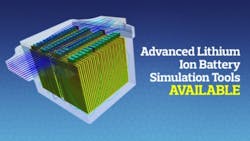Advanced Lithium-Ion Battery Simulation Tools
CD-adapco announced the successful completion of its development project targeting the automotive and lithium ion battery industries, enabling faster design and development of advanced electric drive vehicle power systems. This project, which began in August 2011, is co-funded by the Vehicle Technologies Office in the U.S. Department of Energy (DOE) and managed by DOE's National Renewable Energy Laboratory (NREL). This project is part of the competitive Computer Aided Engineering of electric drive Batteries (CAEBAT) activity launched by DOE in 2010. The initial award of the project was reported on July 7th, 2011 and the project team included CD-adapco, Battery Design Inc, Johnson Controls Inc and A123.
The methods developed within this program are now available within CD-adapco's flagship product STAR-CCM+ and also in the application specific tool, Battery Design Studio. These solutions provide seamless integration between electrochemists and thermal engineers within the battery design process. Through linking the flow, thermal and electrochemical simulations into one environment, a highly accurate solution can be obtained. The models also span multiple computational domains from systems models to highly resolved complex 3D models. The image below shows an example of both the thermal and electrochemical results produced for a 12-cell module.
Ahmad Pesaran, Energy Storage Group Manager in NREL's Transportation and Hydrogen Systems Center, added, "Continued progress developing and linking physics based models of batteries allows developers and designers to better understand the internal behavior of batteries in electric drive vehicles and explore new designs in a virtual environment, reducing the number of prototypes and tests required by a traditional build-break design cycle. The outcome of this project is expected to enable scientists and engineers to further improve the performance, cost, and lifetime of advanced lithium ion batteries in support of the DOE's EV Everywhere Grand Challenge."
